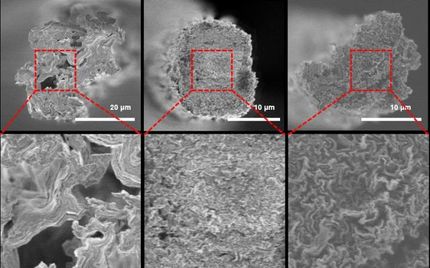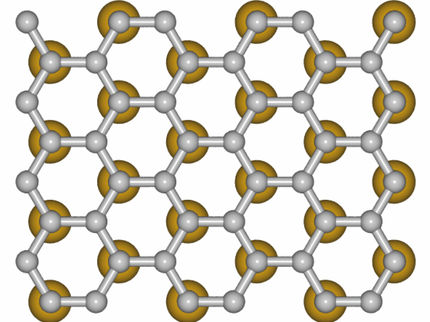Molecular assemblies heal epitaxial graphene on silicon carbide
Scientists at Chalmers University of Technology, Sweden, have made a breakthrough in the way one can control the charge carrier density in graphene. They have discovered a novel method to dope graphene over large areas that enables the study of the physics at the Dirac point, where graphene is charge neutral and electron transport studies are not obscured by mesoscopic effects and charge disorder. The unorthodox method utilizes polymers to assist the assembly of acceptor molecules on graphene.

Spontaneous assembly of molecular dopants (yellow circles) on Dirac crystals via diffusion through polymers. After deposition of polymers by spin-coating (left), the diffusion of dopants in the polymers can be controlled and fine-tuned by thermal annealing (middle), with temperature T of the order of the glass transition temperature Tg of the polymer spacer. When the temperature is lowered below Tg, dopants remain assembled on the surface of the Dirac crystal (right). Polymers serve also the purpose of encapsulation layer, protecting fragile or unstable crystals from ambient.
Hans He
A well-established technology to produce high quality graphene is by heating up silicon carbide (SiC) in the presence of inert Argon gas. Under proper growth conditions, this technique results in so-called epitaxial single layer graphene on the surface of silicon carbide (epigraphene). Compared to graphene grown by other methods, epigraphene grows as a single crystal over the entire silicon carbide substrate, anticipating higher electronic quality with respect to polycrystalline graphene grown by other methods. However, on SiC, the graphene layer interacts very strongly with the substrate resulting in very large transfer of electrons from SiC into the graphene layer. To fully explore and exploit the properties of graphene requires the capability to tune the amount of electrons transferred from the substrate. For epigraphene, the very strong interaction between the graphene layer and SiC substrate makes it difficult to control at will the amount of electron transfer (i.e. doping). The inability to finely dope epigraphene has been a major challenge in studying and exploiting the properties of this promising material.
The scientists have discovered a novel method to carefully assemble molecules on the surface of epigraphene to dope it with unprecedentedly high control, while keeping intact its electronic quality. The method utilizes polymers to assist the assembly of electron-accepting molecules (i.e. dopants) on the surface of graphene; once in contact with graphene, dopant molecules withdraw electrons from graphene and this interaction keeps the molecules in place. To achieve this, polymers are mixed with dopant molecules, and this blend is then deposited on the epigraphene substrate by simple spin-coating, which is a standard and scalable microfabrication step performed in ambient conditions.
“By carefully choosing the polymer, the molecular dopant and the substrate, we have obtained rather exciting results. With a simple spin-coating step, which is routine work in cleanroom environment, we can heal epitaxial graphene and produce a centimeter-scale Dirac material with very high electronic quality. The electronic disorder that we measure in the resulting doped graphene is lower than that of microscopic graphene flakes encapsulated by hexagonal Boron Nitride (hBN), which is the method that thus far results in the highest quality graphene”, says Samuel Lara-Avila at the Quantum Device Physics Laboratory at the Department of Microtechnology and Nanoscienc at Chalmers.
“This is a very unusual example of a highly uniform system that arises from the combination of “dirty” elements: epitaxial graphene is regarded as a lower quality material compared to exfoliated graphene flakes, and both dopants and polymers are known to deteriorate the electronic qualities of graphene. But the combination yields high mobility epigraphene, doped to the Dirac point with high uniformity over macroscopic scale”, adds Sergey Kubatkin, Professor in the same lab.
The researchers used a combination of the common polymer poly methyl methacrylate (PMMA) and the well-known F4TCNQ acceptor molecule to form the dopant blend. They discovered that when the dopant blend is deposited on epigraphene, molecular dopants (i.e. F4TCNQ) diffuse through the polymer and spontaneously assemble at the epigraphene-polymer interface, making a densely packed layer of 3-4 molecules per square nanometer. Surprisingly, this dense assembly of molecules results in epigraphene doped close to the Dirac point with an exceptionally small amount of charge inhomogeneity, i.e. disorder.
Using epigraphene, these results simultaneously show the potency of this method, because epitaxial graphene grown on SiC is particularly difficult to dope while at the same time maintaining its electronic quality.
“We have made a significant progress in approaching a largely unexplored realm of graphene research – a study of delicate fascinating physical properties of macroscopic graphene samples doped at the Dirac point, in which electron transport measurements are not obscured by size-induced mesoscopic effects and charge puddles, typical of microscopic samples”, says Hans He, PhD student in the group.
This method can be the key to explore and exploit the fascinating physical properties of epigraphene and other related Dirac materials. While there exist world-wide efforts to synthesize high quality materials, unintentional impurities or hard-to-reach stoichiometry during material growth result in heavily doped crystals. In this situation, at high doping levels, the interesting physics of Dirac materials might be obscured or entirely absent. A few other examples of novel physical effects expected – made possible by the new results – include study of metal-insulator transitions, interacting Dirac fermions, Wigner crystallization, possibility to observe Zitterbewegung of electrons in Dirac materials, and specular Andreev reflections among others.
“The resulting doped epigraphene is also of technological relevance, and the material is readily applicable in quantum resistance metrology, light sensors and magnetic sensors. But the molecular assembly method can open other research avenues by using a different combination of polymer/dopants, and also when applied to other atomically thin materials”, concludes Samuel Lara- Avila.
Original publication
Hans He, Kyung Ho Kim, Andrey Danilov, Domenico Montemurro, Liyang Yu, Yung Woo Park, Floriana Lombardi, Thilo Bauch, Kasper Moth-Poulsen, Tihomir Iakimov, Rositsa Yakimova, Per Malmberg, Christian Müller, Sergey Kubatkin & Samuel Lara-Avila; "Uniform doping of graphene close to the Dirac point by polymer-assisted assembly of molecular dopants"; Nature Comm.; 2018


































































